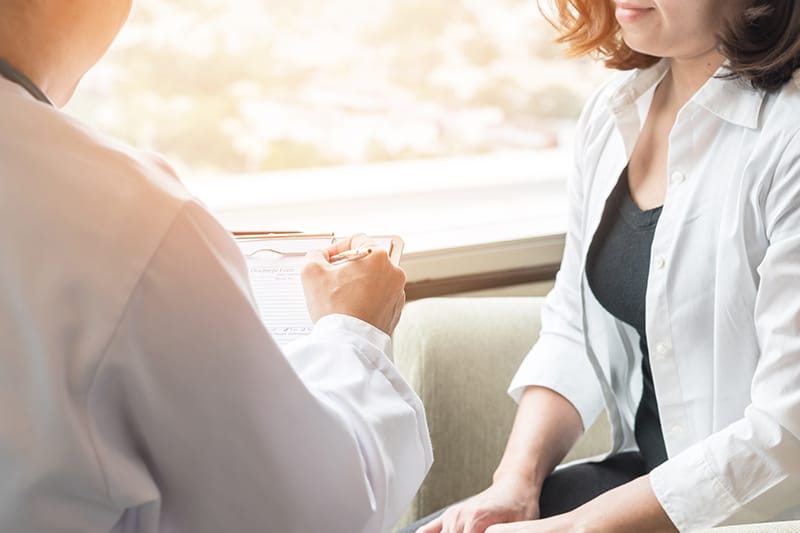What Is a Mammogram?
Mammography is a low-dose x-ray exam that produces images of the breast, known as mammograms. It is essential for the early detection of breast cancers, as it can often reveal changes in the breast before they can be felt by the patient or physician. Research shows that annual mammograms can lead to early detection when breast cancers are most curable and breast-conservation therapies are available. Mammograms can also detect ductal carcinoma in situ (DCIS), which are abnormal cells in the lining of a breast duct that may develop into invasive cancer.
Mammography is the only breast cancer screening tool proven to reduce deaths from the disease.
Why Should I Get a Mammogram?
A mammogram is one of the best tools to detect breast cancer early. Thousands of women’s lives are saved every year by this one routine test. With one in eight women likely to develop breast cancer at some point in their lifetime, it’s understandable to feel anxious about a screening that tells you if you’re one of them. Planning ahead and reminding yourself of the expectations will make you more comfortable before, during and after your mammogram.
When Should I Schedule My Mammogram?
Mammograms are recommended for all women who are 40 or older and have average risk of developing breast cancer. But if you feel a lump, breast thickening, nipple discharge or experience a focal pain, there’s no need to wait until you hit the recommended age to get your mammogram. You can determine if you are considered average risk by having a healthcare provider assess your individual risk factors. If you are under the age of 40, a physician referral may be necessary to schedule a mammogram.
It’s also important to talk it over with your provider. Share any new problems or concerns you have with your breasts, like pain, discomfort, lumps, redness or any other noticeable differences. Fill your doctor in, provide an update on your medical history and get a clinical breast exam so your provider can check for any physical signs from the problems you discussed. This is an important step, as breast concerns may require more specialized evaluation with a diagnostic mammogram or ultrasound instead of a screening.
While a screening mammogram is just once a year, timing is everything. As a patient of The Iowa Clinic, you’ll get a letter one month before you’re due for your breast cancer screening. This gives you flexibility to find the best time to schedule your mammogram. For many women, that’s one week after their period. Sooner and your screening may be less comfortable, as breasts are more tender during the menstrual cycle. If you have a history of cysts that fluctuate with your cycle, that could be another consideration.
How Should I Prepare for my Mammogram?
Once your appointment is on the calendar, you can start preparing for your visit to Medical Imaging. A little prep work helps ensure you have all the information you need, and your appointment goes as quickly as possible.
If you’ve switched clinics, complete this form and we will take care of transferring your previous images. The imaging from previous breast cancer screenings is helpful in spotting the changes and unique nature of your breasts, which can improve the accuracy of your exam.
To increase your comfort during the exam, consider cutting back on caffeine in the days leading up to your appointment. Caffeine is known to increase breast tenderness in some women. You could also take a non-steroidal anti-inflammatory drug like ibuprofen or naproxen to ease breast tenderness or pain.
Also consider skipping your daily swipe of deodorant, as many contain aluminum and calcium, which can look like calcifications on the mammogram images.
Before your exam, you will be sent a request to fill out your medical and family history. Please fill it out as completely as you are able before you arrive.
After your first mammogram, you’ll be asked fewer questions and will just need to verify that your health history is correct.
What to Expect During Your Mammogram
An annual screening mammogram is one of the quickest medical appointments you’ll have. You’re in and out in just 15 minutes.
After you check in, a mammography technologist will meet you in the waiting room and walk you back to the private dressing room where you can change into a gown. You’ll be asked to wipe off any deodorant, lotions or powders near your breasts — these can affect the images taken during your exam.
The mammography technologist will take you back to the exam room and briefly review your provided information. You’ll be asked about your first period, whether you’ve had children, if you’re taking hormones, whether you’ve had surgeries or biopsies and if you or your family has any history of cancer.
During a mammogram, your breasts are compressed between two firm surfaces to spread out the breast tissue. You’ll be asked to hold your breath so there’s no motion while the x-ray tube sweeps over the top, capturing the 3D images.
The compression of your breasts may be uncomfortable for some patients, but it shouldn’t be painful. The imaging process takes only a few minutes, so any discomfort is over quickly. If you do feel pain, tell the mammography technologist right away.
Once the exam is done, you’re free to get dressed and be on your way.
What Happens After My Mammogram?
After the mammogram, a radiologist reads your exam and compiles a report. This report is sent to your primary care provider. You will also receive a letter with your full mammogram results. If you have had outside imaging done, we will wait until those prior images arrive, which may delay when you receive your full report.
About 10% of women get called back for additional imaging, however this does not mean you have breast cancer. Of those 10 percent, over half ultimately find out that they're in the clear. The goal of mammography is to look for any changes in your breast tissue. If it’s your first time, there is a little higher chance of a call back because the radiologist doesn't yet know what your normal breast tissue pattern looks like.
In most cases, a call back means the radiologist need additional images to provide more information on your breast tissue. They may need a better look at a dense or asymmetric area of tissue within your breasts. If follow-up testing is needed, you’ll get a call from our team to schedule a Diagnostic Mammogram.
What is a Diagnostic Mammogram?
If you’re called back for more imaging — or referred because your primary care provider found something in a clinical breast exam — you’re actually scheduled for two back-to-back exams: a diagnostic mammogram and a breast ultrasound.
A diagnostic mammogram takes longer than a screening mammogram. More images are taken of your breast tissue so that the radiologist has the information necessary to make an accurate diagnosis. The whole exam takes about 30 minutes.
The radiologist checks the results of your diagnostic mammogram right away and will order the breast ultrasound, if needed. If additional imaging isn’t necessary, you’re free to go. If you need the breast ultrasound, it will take another 30 minutes, bringing your whole visit to an hour.
Either way, you get the results of your imaging before you leave the clinic.
Mammography FAQ
Unfortunately, the answer is yes. Screening mammography looks for changes in breast tissue and anything that looks different. Breast tissue is moveable, so it can look very different from one year to the next.
The second one is different. You get a routine screening mammogram every year to check out the health of the whole breast. If the radiologist sees an abnormality in that test, he or she will call for a diagnostic mammogram. Those tests zoom in on the specific area of concern to see it in more detail.
While 10 out of every 100 women are called back for further testing, only two will end up with a biopsy. Of the other women, six will be given a benign diagnosis after additional testing and two will get the same diagnosis after a short follow-up course.
There are times when you will not get a screening mammogram and go straight to a diagnostic mammogram. If you have breast pain, a lump or notice anything abnormal through your own self-exam, you've already identified a problem so a focused exam to address that problem is necessary.
Mammograms see differences in density — the white and black on a medical image. Ultrasounds show characteristics of what that density actually is, providing more detail.
The breast ultrasound is not always necessary. But for your convenience, they are always scheduled together — just in case. After reviewing the diagnostic mammogram image, a radiologist will decide whether a breast ultrasound is needed to get more information.
As soon as possible. The waiting game is no fun when it comes to critical news about your health. We make every effort to get back to patients with screening mammography results as soon as they're available and get them scheduled for additional imaging if needed. And when you do need a diagnostic mammogram and breast ultrasound, you hear those results the same day.
Patient Navigators are your go-to source of information for breast health, guiding you through your breast imaging journey, from a routine screening mammogram all the way through scheduling surgery, if necessary. They offer crucial support, from answering questions and coordinating care to improving outcomes and ensuring nothing falls through the cracks.


